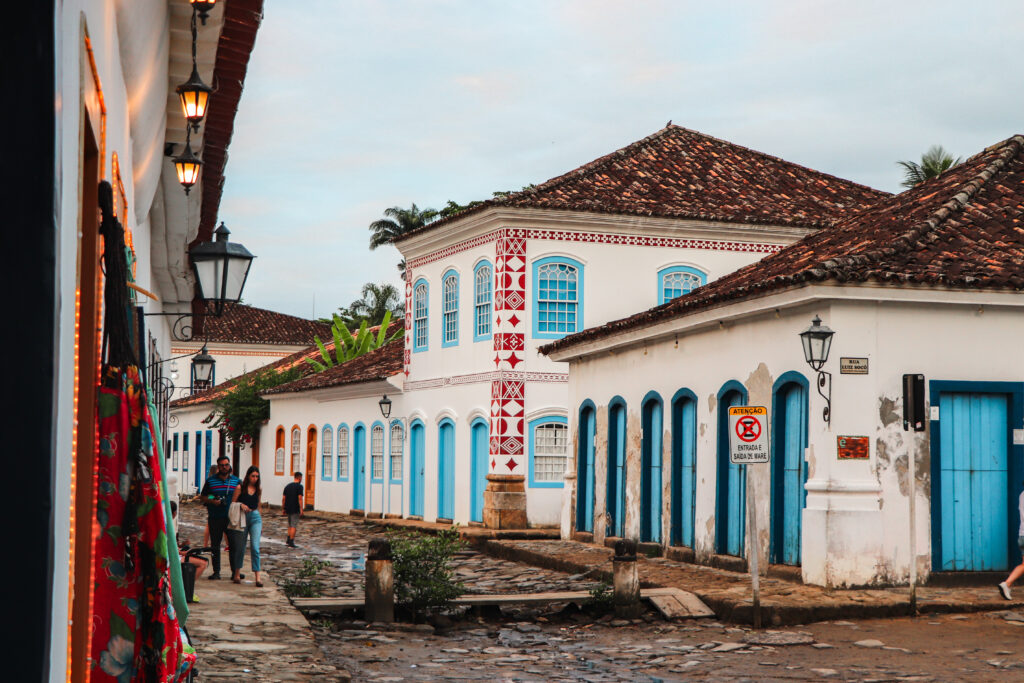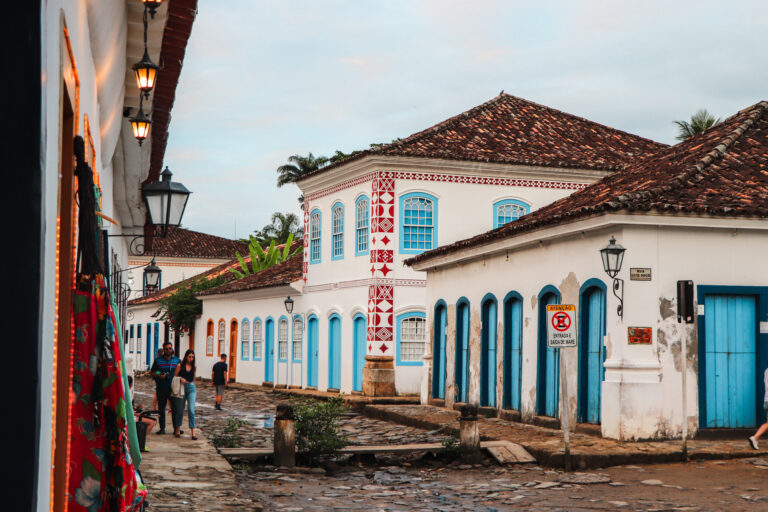Rio de Janeiro pulses with a rhythm unlike any other city. From the renowned Carnival to the iconic golden beaches of Ipanema and Copacabana, and the majestic Christ the Redeemer statue, Rio will for sure leave a lasting impression.
In our travel guide, we’ve gathered the best things to do in Rio de Janeiro to plan your trip. To truly enjoy Rio de Janeiro, just surrender to its infectious energy and let yourself be carried away by the city’s vibe.

14 Best Things to Do in Rio de Janeiro
Rio certainly lives up to its title as the “Marvelous City”. Situated between majestic hills and the shimmering Atlantic Ocean, the panoramic views of this bustling metropolis are simply stunning. Amidst the modern skyscrapers, traces of its colonial heritage from its days as the Portuguese Empire’s capital emerge, adding a distinctive charm to the urban landscape. Rio’s treasures are scattered throughout the city, so plan at least 3 days in the city to enjoy all the best things to do in Rio.
While its reputation for being one of the most dangerous cities in the world may raise concerns, don’t let the anxiety hold you back. We can assure you, that Rio is worth a visit. Just give this vibrant city a chance and you will be surprised by its warmhearted people.
1. Christ the Redeemer Statue
Visiting the Christ the Redeemer statue – the iconic symbol of the city – is obviously the top one best thing to do in Rio de Janeiro. Standing tall at 30 meters and covered with millions of small soapstone tiles, it ranks among the 7 New World Wonders. It is indeed remarkable to see this statue from miles away, standing on top of the 710-meter Corcovado Mountain and embracing the city.

To be honest, we found Christ the Redeemer to be less impressive compared to other wonders of the world like Machu Picchu or Chichen Itza. Interestingly, it wasn’t even the tallest Christ statue globally when the New Seven Wonders were appointed; the one in Cochabamba, Bolivia, exceeded it by over 4 meters.
Relevant Reading
Nevertheless, we still recommend visiting Christ the Redeemer. Even if not solely for the renowned statue itself, the views from the platform over the Sugar Loaf Mountain, as well as the renowned Copacabana and Ipanema beaches, make it an essential stop for any visitor to Rio.


There are three options to visit Christ the Redeemer in Rio. The most popular one is to book a train ticket, bringing you from downtown (here is the correct location, since we ended up at the wrong station) up to the mountain and back, including a scenic ride.
We recommend buying your tickets in advance. The return ticket costs 97.50 BRL (≈ 20 USD), including entrance to the viewing platform. Note that you will have to pick a date and time for your visit when booking ahead.
To ease the online purchase process, use the translator function of your web browser, which seamlessly translates Portuguese into your preferred language.
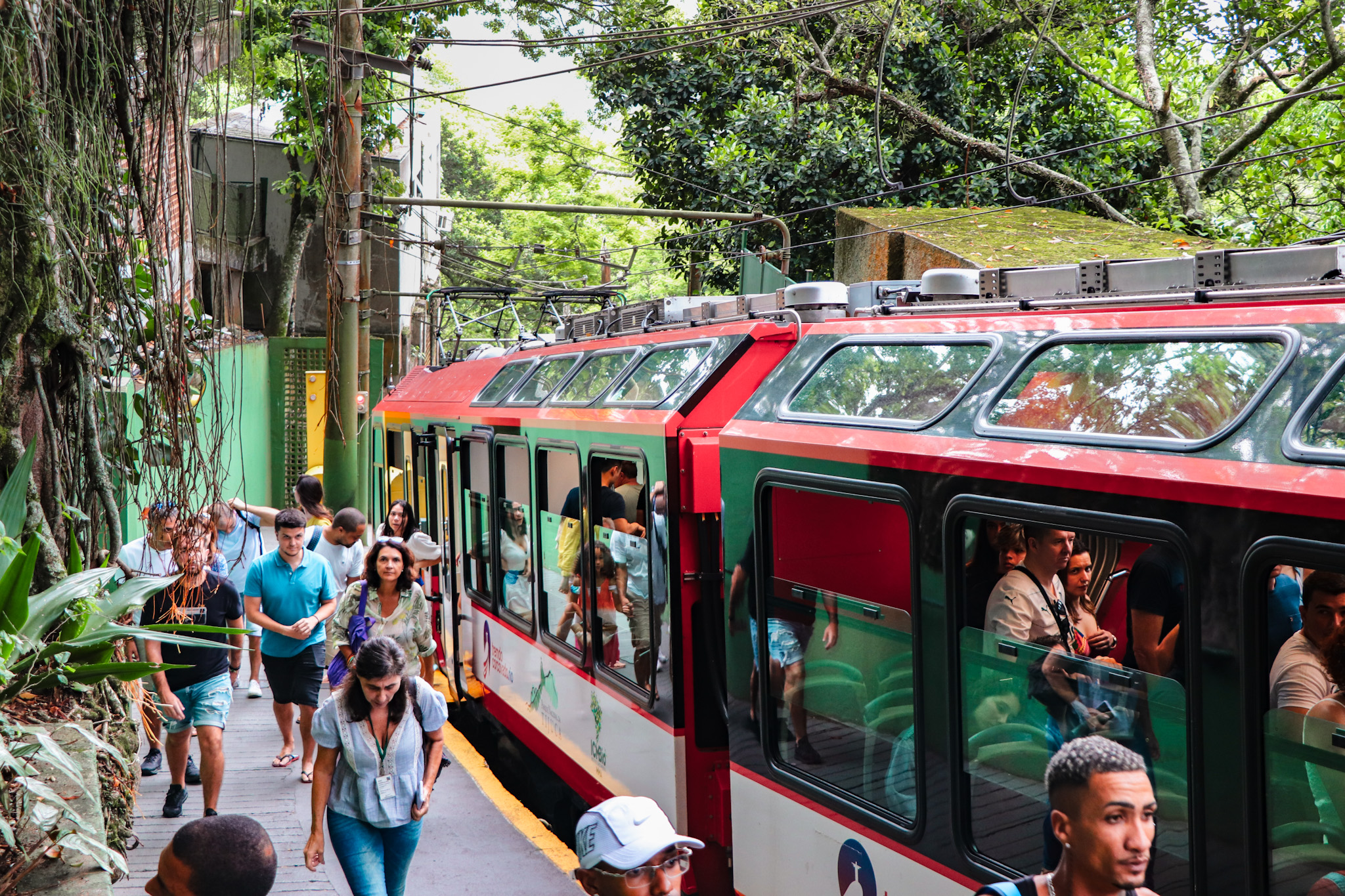
The other option is to take a shuttle bus from one of 3 locations in the City: Largo do Machado, Lido Square in Copacabana (in front of post 2), and Paineiras Corcovado.
The ticket costs between 56.50 BRL (≈ 11 USD) and 101.50 BRL (≈ 21 USD), depending on your starting point. Also for the vans, we recommend buying a ticket in advance here to avoid long queues.
There is also a hiking trail leading to Christ the Redeemer, starting in Parque Lage and taking about 2-3 hours to reach the top.
If you opt for hiking, you only have to pay for the entry ticket, priced at 31 BRL (≈ 6 USD) during the high season and 21 BRL (≈ 4 USD) during the low season. Given numerous reports of muggings along the trail, we advise against this option unless you are hiking in a larger group.

2. Copacabana and Ipanema Beaches
Copacabana and Ipanema are two of Brazil’s most famous beaches. Both beaches offer golden sands and lively bars, to soak up the sun and sip caipirinhas. As for which is better, it’s a matter of personal preference. For the first-timers, we recommend staying around Arpoador to be able to check out both and decide yourself.
When heading to the beach, only bring the most essential valuables with you. Consider packing them in a waterproof pouch, to keep them safe and dry when going for a swim.



During our world trip, we specifically planned Rio on our route to experience the renowned New Year’s Eve celebration at Copacabana Beach, known as Réveillon.
The highlight of the event is a stunning 15-minute firework that lights up the sky above the ocean, literally drawing millions of people to the shoreline. The beach transforms into a party scene, with live music, DJs, dancing, and singing – an infectious atmosphere of excitement and joy as people come together to welcome the arrival of the new year.
It was one of the most amazing New Year’s Eve we’ve experienced!

3. Carnival in Rio
If anyone says Brazil, the carnival of Rio is the first thing that comes to our mind. Colorful costumes, samba rhythms, street parties, and an electrifying atmosphere. The whole city is in celebration. The highlight of the Carnival is the Sambadrome parade, where samba schools compete in a fierce competition to showcase their elaborate floats, dazzling costumes, and synchronized dance routines.
Our world trip schedule did not allow us to visit Rio during the carnival. But next time we will return, there is no way around it. Until then, we are excited to read about your experiences and tips in the comments below.
To make the most of your visit to Rio’s Carnival, it’s essential to plan ahead. Secure accommodations well in advance, as hotels book up quickly during this peak tourism period. The same applies to purchasing tickets for the Sambadrome parade or a tour to ensure you have a prime viewing spot for the festivities. And, of course, expect the experience to come with a high price tag.
4. Selarón Stairs
These colorful Selarón stairs, adorned with colorful tiles from around the world, have become almost as iconic to Rio as the Christ the Redeemer statue. It was a Chilean artist, Jorge Selarón, who grew tired of the mundane appearance of the stairs at his doorstep and decided to transform them into a masterpiece of art.
Running short on tiles to complete the project, Selarón invited people worldwide to send him some. As a result, you may stumble upon tiles from your own country. Laura unexpectedly found herself in front of one depicting Estonia’s capital, Tallinn.
Visiting the Selaron stairs is free. Many free walking tours end here, allowing you to explore the stairs and take pictures at your own pace. Afterward, why not relax and enjoy a refreshing caipirinha? They only cost 6 BRL (≈ 1 USD)!



5. Lapa Neighborhood
Besides the Selaron stairs, the Lapa neighborhood offers even more reasons why it’s worth a visit. During the daytime, you can explore the majestic Arcos da Lapa (Lapa Arches) and the Catedral Metropolitana de São Sebastião.
The Arcos da Lapa are impressive white stone arches that were originally built as an aqueduct but, today, stand as a symbol of the neighborhood. Watch out for the iconic tram to drive over the arches.
Behind the arches, you will find another fascinating landmark. The Catedral Metropolitana de São Sebastião has a unique pyramid shape, reminding of Mayan pyramids. If time allows, step inside the cathedral to witness the stunning play of light streaming through the stained glass windows.
But Lapa neighborhood truly comes alive at night. It’s the place to be for an unforgettable night out, filled with vibrant energy, lively music, and endless entertainment options. Don’t miss out on visiting at least one of the legendary samba clubs, where you can experience the heart and soul of Brazilian music.



6. Historic Downtown
The historic downtown of Rio is the oldest part of the city. It is a fascinating mixture of colonial architecture and modern skyscrapers. We had not found much about the historic downtown in other travel blogs, and thus, were surprised, about how much there is actually to see. Visit the royal palace near the seafront or walk to the most beautiful building in the country – the theatre house. For a lunch break, head to Confeitaria Colombo – a Parisian-style cafe that serves delicious pastries. The downtown is filled with architectural treasures from colonial times and is worth a visit.
Known as the financial district, the downtown is busy during workdays until 7 pm. After that and on the weekends this part of the city turns into a ghost town and is not the safest to walk around. While you can explore the region on your own, you can also join one of the free walking tours to learn more about the first capital of Brazil. Remember that you are expected to leave a small tip when joining free walking tours.

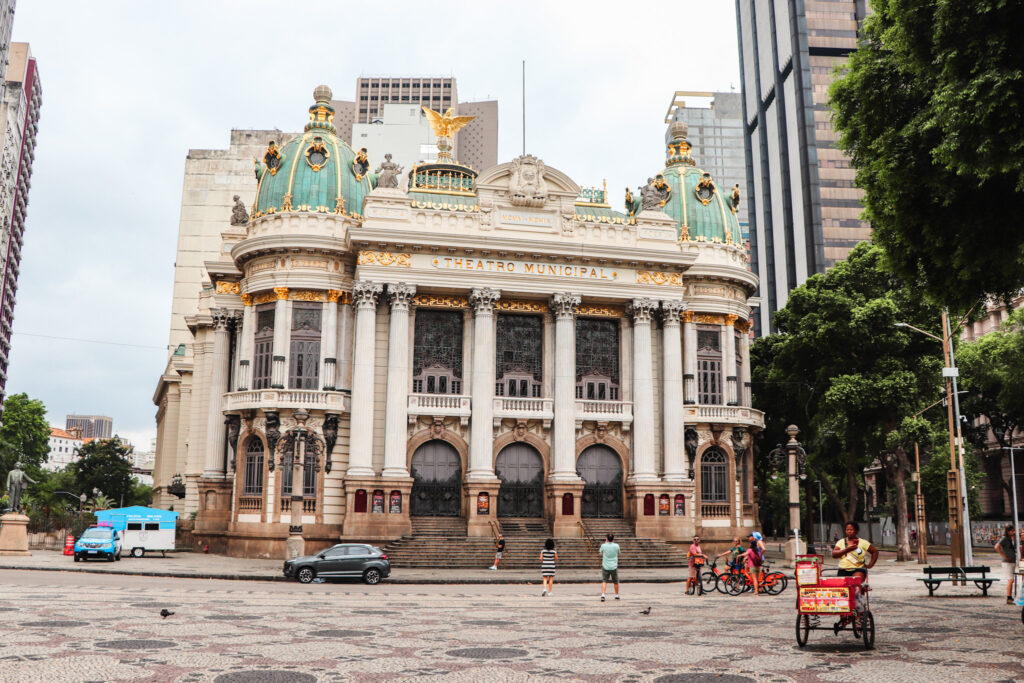

7. Santa Teresa Neighborhood
Santa Teresa is known as the artistic bohemian district of Rio de Janeiro, characterized by colorful graffiti-adorned streets. Once a residential area for the city’s elite, it now boasts a diverse community of middle and working-class residents, including many famous artists. The neighborhood attracts locals and tourists alike with its great restaurants and bars.
While Santa Teresa may seem a bit sketchy at first glance, the neighborhood is generally safe to explore. For extra peace of mind, you can also join a free walking tour.
And of course, no visit to Santa Teresa is complete without hopping aboard (or at least taking a picture of) the iconic tram through the neighborhood’s winding streets, providing panoramic views of Rio’s picturesque landscapes.


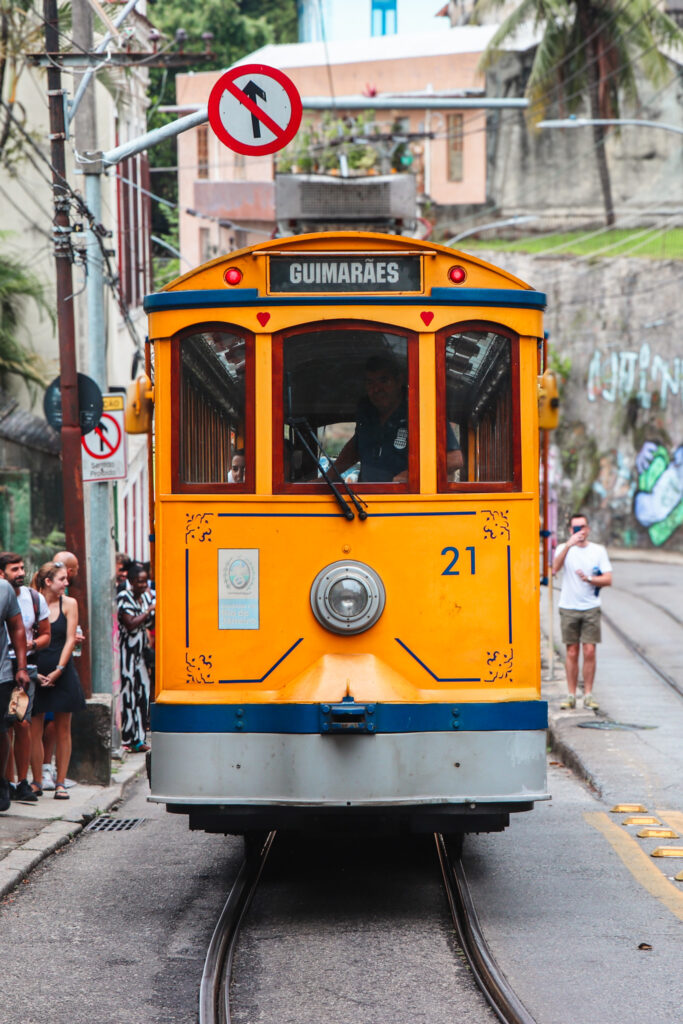
8. Sugarloaf Mountain
Sugarloaf Mountain, or “Pão de Açúcar” in Portuguese, earns its name from its resemblance to the shape of sugar loaves commonly used during the 16th century. This iconic landmark rises 396 meters (1,299 feet) above Rio de Janeiro and is popular among visitors for its stunning panoramic views of the city’s skyline. No worries, cable cars are bringing you to the top. Unless you would rather challenge yourself to climb the mountain.
We highly recommend booking the tickets to Sugarloaf Mountain online in advance. The ticket costs 185 BRL (≈ 38 USD) and gives you the right to a “priority” line over people who buy the tickets on-site.

Having done little prior research, we did not think it would be so crucial to buy our tickets online and ended up waiting in line for over 2 hours until we just gave up (it was during the high season between Christmas and New Year’s Eve, on a Friday afternoon). We were not sad, however, as we did not see it worth the price anyway. And we believe the views from the Christ the Redeemer viewpoint were as beautiful.
If the ticket price seems too salty for you too, we learned later from the locals, that you can also hike the lower Urca Hill for free. The trail starts here and it should take you around 30-40 minutes to reach the top. Since it is a military zone, the trail is considered to be safe.
And then there is also the option to climb up the Sugarloaf mountain. For this, climbing equipment is required, so, best to book a guided tour for about 65 USD.

9. Etnias graffiti mural by Eduardo Kobra
The massive Etnias mural by famous graffiti artist Eduardo Kobra was created to celebrate the 2016 Rio Olympics. Depicting indigenous peoples from five continents, it is also a celebration of diversity and unity.
Spanning an entire city block in the Olympic Boulevard area, “Etnias” is one of the largest graffiti murals in the world, covering approximately 190 meters in length and 15 meters in height. We were flashed by the enormous size of this masterpiece.



10. Museum of Tomorrow
Walking down the Olympic Boulevard you will reach the Museum of Tomorrow (Museum do Amanhã). It is known for its unique contemporary architecture and, inside, this futuristic science museum examines the challenges and possibilities of the future, focusing on themes such as sustainability, climate change, technology, and human innovation.
The museum is open from Tuesday to Sunday, from 10:00 am to 6:00 pm (last entry at 5:00 pm), including holidays. The ticket costs 30 BRL (≈ 6 USD).

11. Watch a soccer game
12. Tijuca Forest
For the hikers among us, Tijuca Forest in Rio de Janeiro is worth visiting for its stunning waterfalls, diverse flora and fauna, and panoramic views of Rio. It is one of the largest urban forests on our planet!
The best hikes include the trail to Pedra Bonita for views of the city and the challenging trek to the summit of Pico da Tijuca, the highest peak in the forest.

13. Rio's Botanical Garden
The Botanical Garden of Rio de Janeiro, or Jardim Botânico, is a perfect place to escape the city buzz. Stroll down the winding pathways that lead through a variety of landscapes, from dense rainforests to manicured gardens. Don’t miss the highlights like the Chrystal Palace, Avenue of Royal Palms, a majestic row of towering palm trees, and the Orchidarium, which showcases a collection of orchids from Brazil and around the world.
Botanical Garden is open on Monday and Tuesday, and Thursday through Sunday, from 8 am to 5 pm. The entrance costs 73 BOB (≈ 11 USD). Keep in mind, that the payment at the box office is only in cash.

14. Tropical Beaches of Ilha Grande or Arraial do Cabo
Escape to a coastal paradise with a trip to Ilha Grande or Arraial do Cabo. With crystal-clear waters and soft sands, both places are ideal for a relaxing beach time. Dive into the turquoise waters for a swim, catch some waves with a thrilling surfing session, or explore the vibrant marine life beneath the surface through diving. And when hunger strikes, head to one of the local eateries for fresh seafood delicacies.
In case you only have limited time and are planning to do a day trip to one (or both) of the beaches, we recommend booking an organized tour, as both destinations are about a 3-hour drive from Rio. A day tour from Rio including a boat ride costs between 60 and 80 USD.

How to get to Rio?
Rio de Janeiro is a well-connected metropolis, easily accessible both domestically and internationally. With a variety of transportation options available, you can choose the one that best suits your starting point and preferences.
Travel to Rio by plane
Rio de Janeiro is served by two major airports: Galeão International Airport (GIG) and Santos Dumont Airport (SDU). These airports offer domestic and international flights from various destinations around the world.
Once you arrive in Rio de Janeiro, taxis and ride-sharing services, are available to reach your final destination within the city. We paid only 11 USD for an Uber ride to the airport but expect to pay between 13 USD and 25 USD for a taxi. In case you are traveling on a budget, you can also use buses (line 915) or the metro (take the BRT Express TransCarioca to the L2 metro station called Vincente de Carvalho metro station) for further travel, costing only a few bucks. Just be extra careful with your luggage.
Travel to Rio by bus
If you are traveling from within Brazil, you can take a long-distance bus to Rio de Janeiro. There are several bus companies operating routes to Rio from cities across Brazil. The main bus terminal in Rio de Janeiro is the Novo Rio Bus Station (Rodoviária Novo Rio), located in the North Zone of the city.
Once you arrive in Rio de Janeiro, you have several options to reach your final destination in the city, including public transportation, taxis, or ride-sharing services. If you prefer ride-sharing services like Uber, you’ll need to head to the departures section on the other side of the building for pick-ups (via the first floor). We only paid 5 USD for a ride to Copacabana. For a taxi, it’s advisable to use a licensed one, which you can conveniently order from the official booth inside the terminal.
You have two options for purchasing bus tickets: either directly at the terminal or online through the bus companies’ websites. It’s recommended to book in advance, especially during peak travel periods, to guarantee your seat. However, in many cases, booking online requires a local CPF number, making it challenging. As a result, we often end up buying tickets at the terminal instead.

From São Paulo to Rio by bus
Several bus companies are operating on the route day and night. The journey typically takes around 6 to 7 hours. Keep in mind that most buses to Rio depart from the Tietê Bus Terminal (Terminal Rodoviário Tietê) in the north of the city.
A bus ticket from São Paulo to Rio costs between 80 BRL (≈ 16 USD) and 380 BRL (≈ 77 USD), depending on your time of booking and the chosen comfort class. You can check timetables and prices directly on Penha’s website or Itaperimim’s site.
From Paraty to Rio by bus
It’s a 5-hour trip from Paraty to the Rio de Janeiro Bus Terminal Rodoviário Novo. Buses of Costa Verde company leave regularly and ticket costs 99 BRL (≈ 20 USD). Check the schedule and buy your tickets online here (no CPF required).
Relevant Reading
From Ilha Grande to Rio by bus
To travel from Ilha Grande to Rio de Janeiro by bus, you’ll first need to take a ferry from Ilha Grande to Angra dos Reis. From Angra dos Reis, you can catch a bus to Rio de Janeiro. Buses operate frequently between the two cities, and the journey takes around 2.5 to 3.5 hours.
To find bus schedules and purchase tickets, you can visit the bus station in Angra dos Reis or check online on Costa Verde’s website. The ticket costs about 10 USD. There are also private shuttle bus services available for 60-70 USD per person.
Where to stay in Rio?
When choosing where to stay in Rio de Janeiro, prioritize safety by opting for well-established neighborhoods with a strong police presence, such as Copacabana, Ipanema, or Leblon. Each area offers a great experience, from luxury hotels to budget-friendly accommodations, with nice cafes and a wide variety of restaurants and bars. It’s best to look for accommodations with security measures like 24-hour reception and secure entrances.
If you’re planning to visit Rio during New Year’s Eve or Carnival, book your accommodation well in advance. These are peak times, and availability can be limited, with prices soaring. Secure your lodging as soon as possible to ensure you have a place to stay and to avoid inflated costs.
Where to eat in Rio?
Rio de Janeiro offers a diverse culinary scene, offering a mix of upscale restaurants, casual eateries, and beachside kiosks serving fresh seafood and Brazilian snacks such as açaí bowls. The city is known for its barbecue (churrasco) restaurants, where you can enjoy an all-you-can-eat feast of grilled meats served tableside. But they also have extended the concept to pizzas and sushi.
There is no way one can try out all the good restaurants in Rio. But here are some popular restaurants to consider when looking for places to eat:
Churrascaria Palace
- Brazilian
- High
Authentic Brazilian barbeque place (Churrascaria) and steakhouse. They have a wide range of prime cuts, oysters, and sushi too.
Coco Bambu
- Brazilian
- High
A delicious seafood restaurant in the iconic Botafogo district of Rio. Perfect place to treat yourself with some fresh fish.
Confeitaria Colombo
- International
- High
One of the most iconic cafés and bakeries in the historic center of Rio de Janeiro. Enjoy delicious pastries in a beautifully preserved historic setting.
How to get around Rio?
For more safety, our first go-to transport option is always ride-sharing services like Uber, which are readily available in the city and quite affordable. As for taxis, we highly recommend making sure to only hail licensed yellow taxis with a blue stripe on the side. Better yet, let the hotel reception order one for you.
In case you are traveling on a budget, Rio de Janeiro has an extensive public transportation system, including buses, metro, and suburban trains, which can take you to most areas efficiently and affordably. We’ve heard it’s better to stick to the metro than buses. And be extra careful with your valuables.
In neighborhoods, such as Copacabana and Ipanema, walking and biking are great ways to explore the area, as they are safe, pedestrian-friendly, and offer beautiful views along the way.

When is the best time to visit Rio?
There is no single best time to visit Rio de Janeiro.
If you are looking for the most pleasant temperatures and beach weather, visit Rio during the summer months from December to March. During this time the climate is hot and humid, but you’ll need to expect some occasional downpours. The summer months are also the busiest tourist-wise, so keep that in mind when booking your trip to Rio.
Another option is to visit Rio de Janeiro during the shoulder season in Spring. Spring in Rio lasts from September to November and combines the benefits of both winter and summer. Prices are still affordable and the weather is warm enough to take a swim in the ocean.
June to August is the time where prices are the lowest and least people visit Rio. It’s winter time, so it gets quite chilly, but if you don’t mind wearing some layers of cloths and missing out on a dip in the sea, it’s a good time to explore the city.
If you’re looking to experience Carnival, plan your visit to Rio for February or early March. Keep in mind that Rio can be crowded and prices skyrocket during Carnival, so it’s important to plan and book accommodations early.
Here is our detailed overview of the best travel times for Rio de Janeiro:
What does it cost to visit Rio?
We were surprised to find that Brazil, in general, tends to be more expensive compared to other South American countries. In Rio de Janeiro, prices are comparable to those in larger cities in the US and Europe. For budget travelers, expect to spend around 50 to 70 USD per day, while those seeking a more luxurious stay may spend up to 200 USD per day.
However, it’s important to note that prices skyrocket during New Year’s Eve and Carnival due to high demand. Accommodation prices can rise to a minimum of USD 120 per night. When planning your visit for these events, be sure to budget accordingly and book well in advance to get the best offers.
Please note that flight prices are not included in the cost overview, as they vary depending on your departure country and time of booking.
How many days to stay in Rio?
Spend a minimum of three full days in Rio to see the most important highlights and get a glimpse of its unique vibe. Better yet, extend your stay to 5-7 stay, to fully dive into city’s electric vibes and enjoy a few relaxing days at the beach-
On your first day, learn about the city’s and cariocas’ (locals living in Rio) history with a free walking tour of the historic downtown area. Continue your tour to the Lapa neighborhood to visit the spectacular Selaton stairs, the white arcs, and the metropolitan cathedral. Lastly’ admire the huge Etnias mural in Rio’s port area and visit the Museum of Tomorrow.
On the next day in Rio, visit the iconic Christ the Redeemer statue, and soak up the sun at Ipanema Beach. Grab yourself a caipirinha or two.
On the third day, explore the charming streets of Santa Teresa, known for its graffitis and bohemian atmosphere either with a free walking tour or on your own. Then, head to Sugarloaf Mountain for panoramic views of Rio’s skyline before relaxing on the Copacabana Beach.
As night falls, enjoy Rio’s lively nightlife scene offering loads of trendy bars and clubs with live music. Just keep in mind that it is still a dangerous city, so limit your alcohol consumption to avoid any risky situations.

Is Rio safe to visit?
We were a bit anxious before traveling to Rio. Sadly, the reputation of Rio has gotten so bad that we have even read people asking in online forums how realistic it is to get shot in the city. And while we can’t deny that Rio de Janeiro has its safety challenges, at this point, we want to calm anyone who is doubting their travel plans.
All the touristic areas are generally safe and well guarded by the police and there is no need to get paranoid. But one can always be in the wrong place at the wrong time.
We went to celebrate New Year’s Eve at Copacabana beach and were fearing crazy crowds and pickpockets. However, we were pleasantly surprised by the peaceful and civilized atmosphere. It turned out to be one of the most enjoyable New Year’s Eve experiences we’ve had.
We believe that everyone can do a lot to minimize the risk of falling victim to petty theft or robbery. First and foremost, avoid large crowds and remain vigilant of your surroundings. If a situation seems off, trust your instincts and leave the area.
To minimize the risk of falling victim to petty theft or robbery, there are several precautions you can take. Additionally, dressing modestly and avoiding displaying valuables can help deter potential thieves. This means, to only take your phone out to take a picture or check the direction, and put it back right after.
When using taxis or Ubers, ensure that windows are closed, and doors are locked, and refrain from using your phone visibly, especially when stopped at red lights.
By staying alert and using common sense, you can explore Rio de Janeiro while minimizing risks and enjoying all that the Marvelous City has to offer.

Is Rio worth visiting?
Rio de Janeiro is not just another big city. Its unique location, surrounded by forests, hills, and ocean, is what sets it apart.
While Rio offers countless attractions, such as Christ the Redeemer and Selaron stairs, you’ll truly start loving it once you let go of safety worries and embrace its lifestyle and vibes. Cruise along the promenade on your bike, dive into the waves and sip caipirinhas as you soak up the atmosphere.
This is what makes Rio and why we would always return for a second visit to this amazing metropolis.




